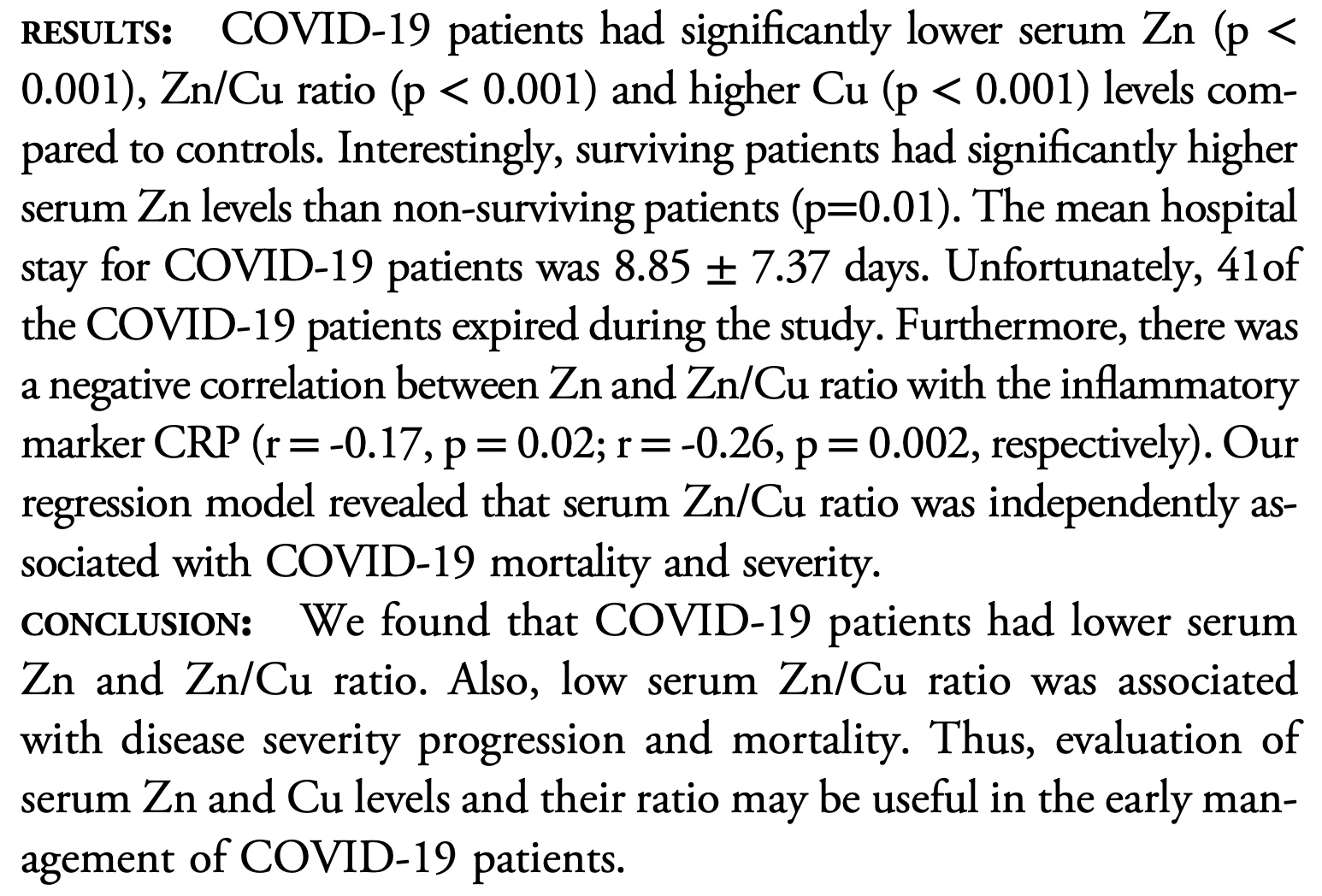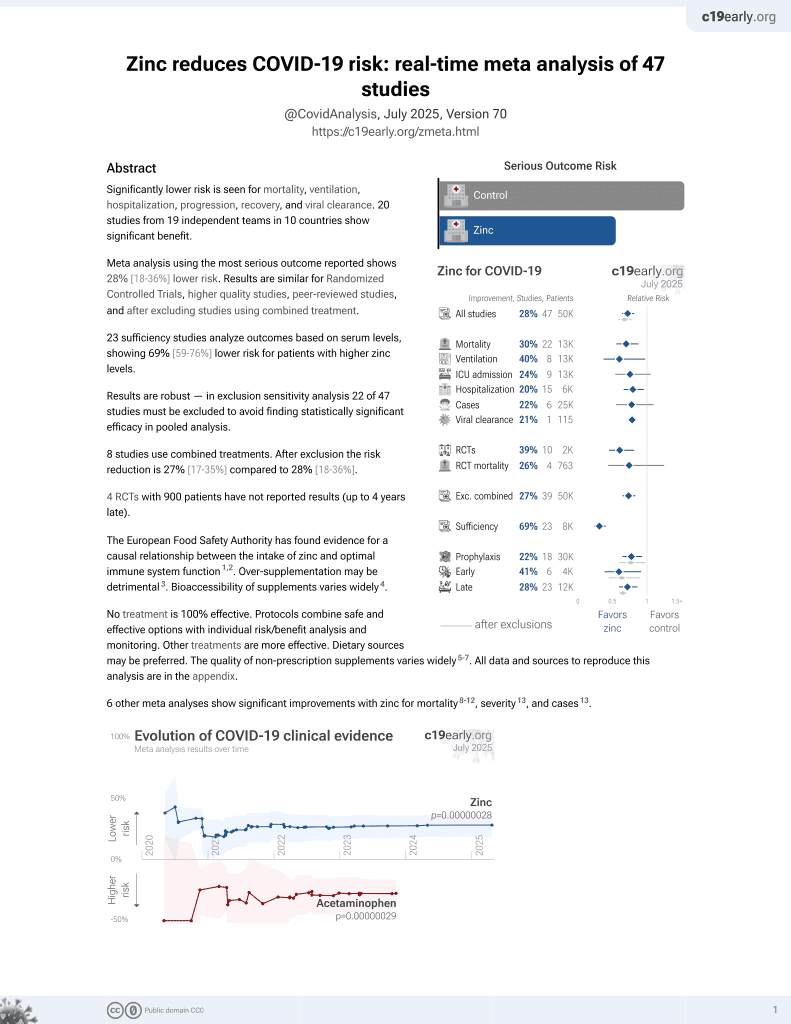
The Clinical Significance of Zinc to Copper Ratio in the Early Management of COVID-19 and its Association with Disease Severity and Mortality
et al., Clinical Chemistry, doi:10.1093/clinchem/hvaf086.312, Oct 2025
Zinc for COVID-19
2nd treatment shown to reduce risk in
July 2020, now with p = 0.00000028 from 47 studies, recognized in 23 countries.
No treatment is 100% effective. Protocols
combine treatments.
6,300+ studies for
210+ treatments. c19early.org
|
Retrospective 220 hospitalized COVID-19 patients and 220 healthy controls showing that COVID-19 patients had significantly lower zinc levels, and that patients that died had significantly lower zinc levels than surviving patients.
Yarahmadi et al., 2 Oct 2025, multiple countries, peer-reviewed, 2 authors.
Abstract: Abstracts
a notable increase in Para 3. In the post-pandemic era from 2023 to
April 2024, the number of detected pathogens significantly increased
once again, with especially notable increases in Para 1-4, Influenza A
(H1-2009 and H3), Influenza B, and hMPV.
4.Co-detection Analysis: Single detection was the most common, with
rates of 88.3%, 88.5%, 75.1%, 66.3%, and 62.3% from 2020 to
2024. Co-detection increased yearly, including triple and quadruple
detections, with the highest positive rates found in the 2-6 years age
group.
CONCLUSION: With the adjustment and improvement of these public
health measures, a significant change in the trends of pathogen prevalence has been observed, demonstrating that the implementation of
public health policies has a direct and profound impact on controlling
the spread of respiratory pathogens. To better address future public
health challenges, continuous monitoring and analysis of the prevalence trends of respiratory pathogens have become particularly
important.
Abstract citation ID: hvaf086.312
A-324 The Clinical Significance of Zinc to Copper Ratio in
the Early Management of COVID-19 and its Association
with Disease Severity and Mortality
Amir Yarahmadia and Seyedeh Zahra Lotfib
Thomas Jefferson University, Philadelphia, Pennsylvania
b
Mashhad University of Medical Sciences, Mashhad, Iran, Islamic
Republic of
a
BACKGROUND:
a
a
Linkou Chang-Gung Memorial Hospital, Taoyuan, Taiwan.
BACKGROUND:
Since the outbreak of the COVID-19 pandemic at
the end of 2019, global public health systems and various societal
aspects have undergone significant changes, particularly among children who experienced an immune window, resulting in notable differences in infection patterns and disease severity. This study
utilized a multiplex real-time polymerase chain reaction
(RT-PCR) diagnostic kit to simultaneously detect the nucleic acids
of various common respiratory pathogens and analyzed the changes
in the epidemic trends of these pathogens before and after the
COVID-19 pandemic
METHODS: This study collected results from the FilmArray
Respiratory Panel (FA-RP) tests conducted at Linkou Chang
Gung Memorial Hospital’s Department of Laboratory Medicine
from 2020 to 2024. The data was grouped by five age categories:
0-2 years (infants and toddlers), 2-6 years (preschool children),
6-12 years (children), 12-18 years (adolescents), and over 18 years
(adults).
RESULTS: 1.Overall Positive Rate Changes: From 2020 to 2024, the
overall positive rate of respiratory pathogens significantly increased,
with rates of 64.3%, 51%, 70%, 86%, and 80.9%, respectively.
2.Age Group Positive Rate Changes: The preschool children group
showed the highest positive rates, with rates of 55.3%, 53.4%,
51.6%, 56.5%, and 39.82% from 2020 to 2024.
3.Pathogen Type Changes: The results indicate that HRV/EV, RSV,
and AD are the predominant pathogens. In 2020, during the pandemic control phase, the distribution of pathogens was relatively even.
During the more severe domestic outbreak period from 2021 to
2022, there was a decreasing trend in the variety of pathogens, with
i130
Clinical Chemistry 71:S1 (2025)
COVID-19, caused by the SARS-CoV-2 virus, can
trigger a severe cascade of inflammatory responses in the body, called
cytokine storm, leading to acute respiratory distress syndrome and
other complications associated with COVID-19. Zinc (Zn) and copper (Cu) are among the most abundant trace elements in the human
body and have various anti-inflammatory..
DOI record:
{
"DOI": "10.1093/clinchem/hvaf086.312",
"ISSN": [
"0009-9147",
"1530-8561"
],
"URL": "http://dx.doi.org/10.1093/clinchem/hvaf086.312",
"abstract": "<jats:title>Abstract</jats:title>\n <jats:sec>\n <jats:title>Background</jats:title>\n <jats:p>COVID-19, caused by the SARS-CoV-2 virus, can trigger a severe cascade of inflammatory responses in the body, called cytokine storm, leading to acute respiratory distress syndrome and other complications associated with COVID-19. Zinc (Zn) and copper (Cu) are among the most abundant trace elements in the human body and have various anti-inflammatory properties that affect the innate and adaptive immune systems. The objective of this study was to evaluate the association of Zn and Cu levels and Zn/Cu ratio with COVID-19 severity and mortality.</jats:p>\n </jats:sec>\n <jats:sec>\n <jats:title>Methods</jats:title>\n <jats:p>A total of 220 COVID-19 patients and 220 healthy age- and sex-matched controls were enrolled in this study. The COVID 19 diagnosis was confirmed by positive qRT-PCR and clinical criteria (signs, respiratory symptoms and chest CT findings). Clinicopathologic characteristics of COVID-19 patients and relevant laboratory parameters including WBC, platelet count, hemoglobin, albumin, blood glucose, kidney and liver function tests, lactate dehydrogenase, creatine phosphokinase, blood coagulation tests, D-dimer, iron, inflammatory marker CRP, electrolytes Na, K, Ca, P, Mg, Zn and Cu levels were assessed at hospital admission.</jats:p>\n </jats:sec>\n <jats:sec>\n <jats:title>Results</jats:title>\n <jats:p>COVID-19 patients had significantly lower serum Zn (p &lt; 0.001), Zn/Cu ratio (p &lt; 0.001) and higher Cu (p &lt; 0.001) levels compared to controls. Interestingly, surviving patients had significantly higher serum Zn levels than non-surviving patients (p=0.01). The mean hospital stay for COVID-19 patients was 8.85 ± 7.37 days. Unfortunately, 41of the COVID-19 patients expired during the study. Furthermore, there was a negative correlation between Zn and Zn/Cu ratio with the inflammatory marker CRP (r = -0.17, p = 0.02; r = -0.26, p = 0.002, respectively). Our regression model revealed that serum Zn/Cu ratio was independently associated with COVID-19 mortality and severity.</jats:p>\n </jats:sec>\n <jats:sec>\n <jats:title>Conclusion</jats:title>\n <jats:p>We found that COVID-19 patients had lower serum Zn and Zn/Cu ratio. Also, low serum Zn/Cu ratio was associated with disease severity progression and mortality. Thus, evaluation of serum Zn and Cu levels and their ratio may be useful in the early management of COVID-19 patients.</jats:p>\n </jats:sec>",
"article-number": "hvaf086.312",
"author": [
{
"affiliation": [
{
"name": "Thomas Jefferson University , Philadelphia, Pennsylvania"
}
],
"family": "Yarahmadi",
"given": "Amir",
"sequence": "first"
},
{
"affiliation": [
{
"name": "Mashhad University of Medical Sciences , Mashhad, Iran, Islamic Republic of"
}
],
"family": "Lotfi",
"given": "Seyedeh Zahra",
"sequence": "additional"
}
],
"container-title": "Clinical Chemistry",
"content-domain": {
"crossmark-restriction": false,
"domain": []
},
"created": {
"date-parts": [
[
2025,
10,
2
]
],
"date-time": "2025-10-02T03:39:55Z",
"timestamp": 1759376395000
},
"deposited": {
"date-parts": [
[
2025,
10,
2
]
],
"date-time": "2025-10-02T03:39:55Z",
"timestamp": 1759376395000
},
"indexed": {
"date-parts": [
[
2025,
10,
2
]
],
"date-time": "2025-10-02T04:10:50Z",
"timestamp": 1759378250570,
"version": "build-2065373602"
},
"is-referenced-by-count": 0,
"issue": "Supplement_1",
"issued": {
"date-parts": [
[
2025,
10
]
]
},
"journal-issue": {
"issue": "Supplement_1",
"published-online": {
"date-parts": [
[
2025,
10,
2
]
]
},
"published-print": {
"date-parts": [
[
2025,
10,
2
]
]
}
},
"language": "en",
"license": [
{
"URL": "https://academic.oup.com/pages/standard-publication-reuse-rights",
"content-version": "vor",
"delay-in-days": 0,
"start": {
"date-parts": [
[
2025,
10,
1
]
],
"date-time": "2025-10-01T00:00:00Z",
"timestamp": 1759276800000
}
}
],
"link": [
{
"URL": "https://academic.oup.com/clinchem/article-pdf/71/Supplement_1/hvaf086.312/64462063/hvaf086.312.pdf",
"content-type": "application/pdf",
"content-version": "vor",
"intended-application": "syndication"
},
{
"URL": "https://academic.oup.com/clinchem/article-pdf/71/Supplement_1/hvaf086.312/64462063/hvaf086.312.pdf",
"content-type": "unspecified",
"content-version": "vor",
"intended-application": "similarity-checking"
}
],
"member": "286",
"original-title": [],
"prefix": "10.1093",
"published": {
"date-parts": [
[
2025,
10
]
]
},
"published-online": {
"date-parts": [
[
2025,
10,
2
]
]
},
"published-other": {
"date-parts": [
[
2025,
10
]
]
},
"published-print": {
"date-parts": [
[
2025,
10,
2
]
]
},
"publisher": "Oxford University Press (OUP)",
"reference-count": 0,
"references-count": 0,
"relation": {},
"resource": {
"primary": {
"URL": "https://academic.oup.com/clinchem/article/doi/10.1093/clinchem/hvaf086.312/8270332"
}
},
"score": 1,
"short-title": [],
"source": "Crossref",
"subject": [],
"subtitle": [],
"title": "A-324 The Clinical Significance of Zinc to Copper Ratio in the Early Management of COVID-19 and its Association with Disease Severity and Mortality",
"type": "journal-article",
"volume": "71"
}
